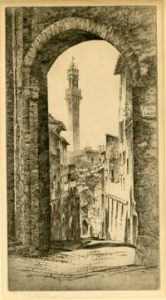June 15 – August 26, 2017

In a historical sense, the Grand Tour was a seventeenth- to eighteenth-century phenomenon in which the young, usually male and aristocratic, members of English and Northern European families visited great cities and societies of the European continent. It was an educational trip, meant largely for cultural exposure and refinement. Art was central to this travel in a number of ways, from visiting masterpieces of painting and architecture, to commissioning portraits, buying art to bring home, and engaging an artist for the journey who would paint the sublime beauty of each destination. This exhibition explores a time from approximately 1880 to 1960 when American artists endeavored to follow in the footsteps of this tradition and trek to Europe for a variety of reasons: study and opportunities to exhibit, illustration on commission, war, and leisure. At the center of their journeys was also the goal of education, for themselves through the process of travel and study and for others through the skills, cultural enlightenment, and artwork they would bring home. The works included in the exhibition represent a range of media, from printmaking to painting, and the work documents the architecture, scenery, and people of Italy, the Netherlands, Spain, Greece, England, and France as the artists saw them.
American Artists and the Legacy of the Grand Tour, 1880–1960 is organized by the Vanderbilt University Fine Arts Gallery and curated by Margaret F. M. Walker, assistant curator, with support provided by the Fine Arts Gallery Gift Fund and the Sullivan Art Collection Fund.